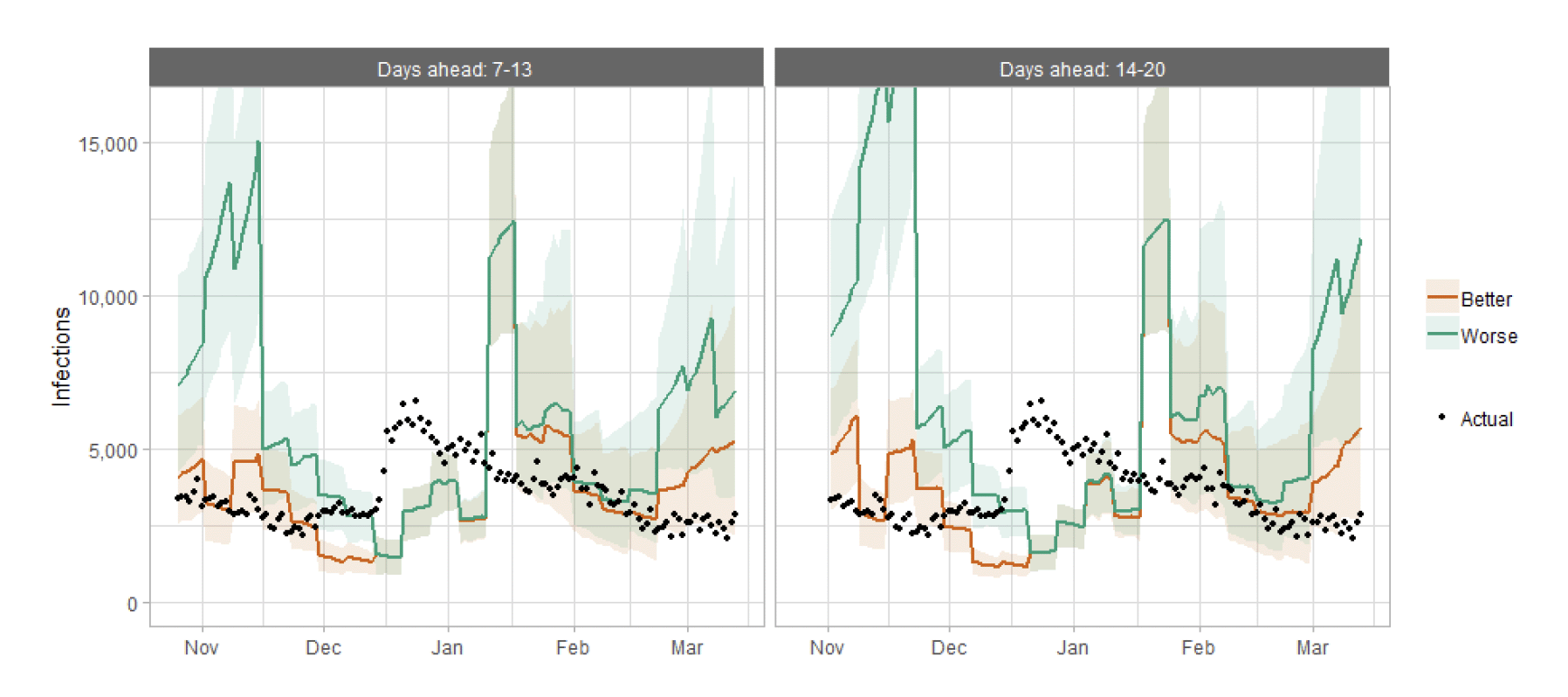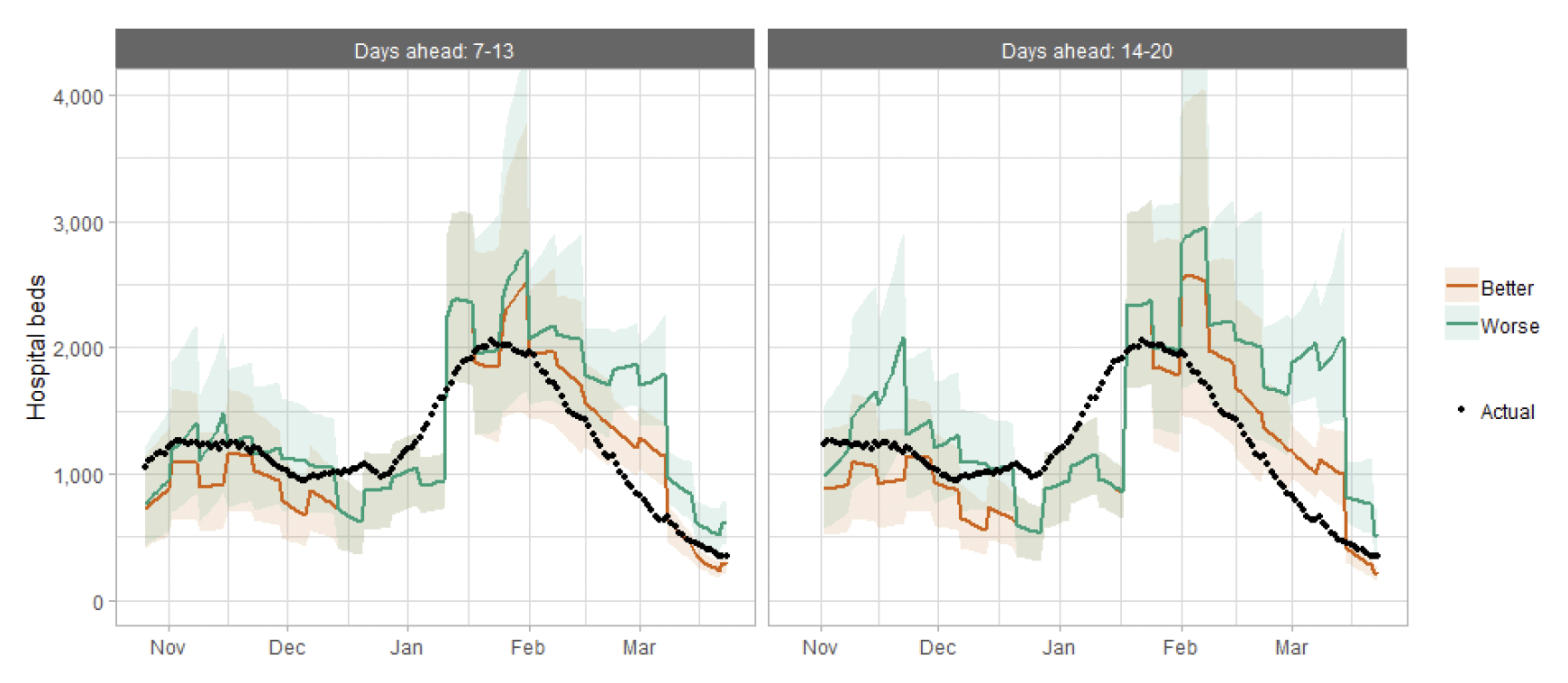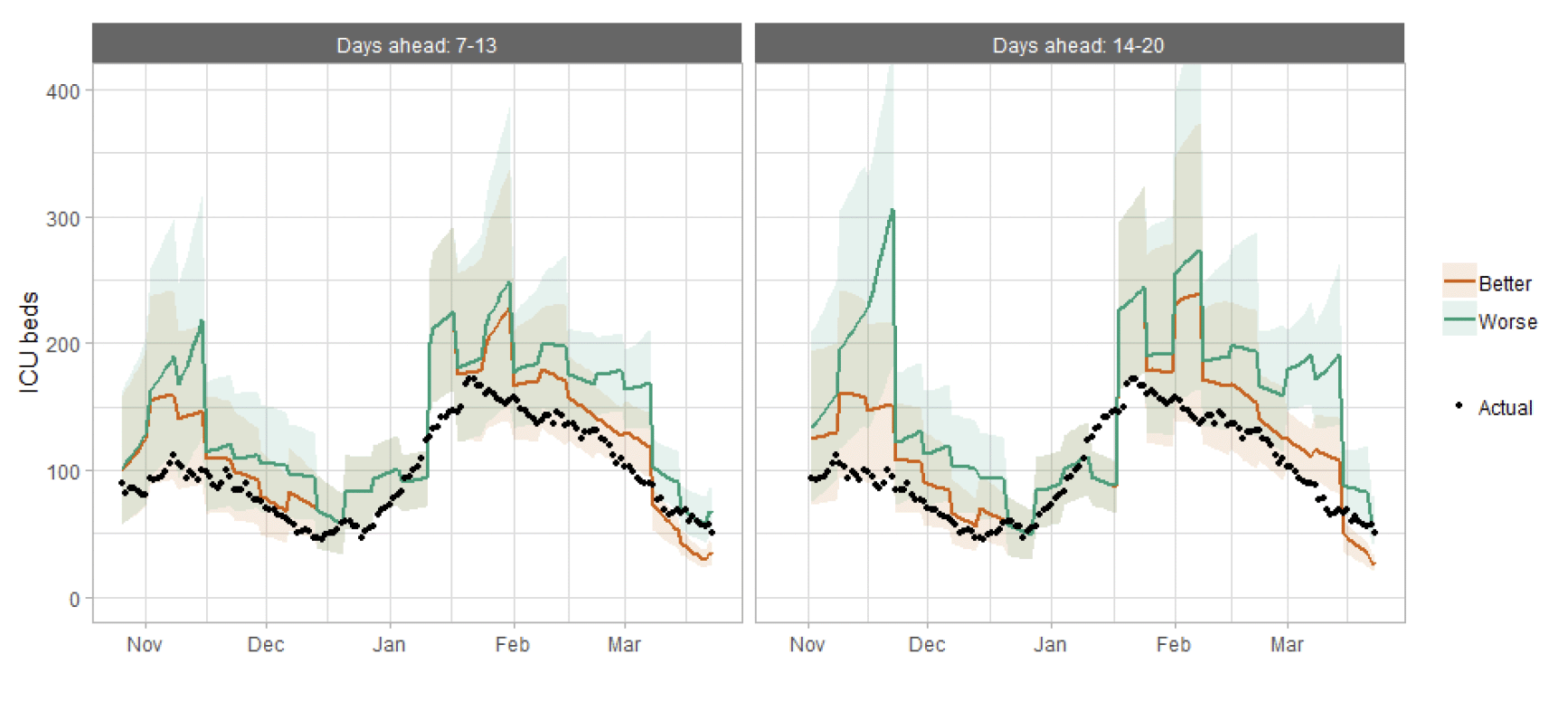Coronavirus (COVID-19): modelling the epidemic (issue no. 44)
Latest findings in modelling the COVID-19 epidemic in Scotland, both in terms of the spread of the disease through the population (epidemiological modelling) and of the demands it will place on the system, for example in terms of health care requirement.
This document is part of a collection
Technical Annex - How the modelling compares to the real data as it emerges
The following charts show the history of our modelling projections in comparison to estimates of the actual data. The infections projections were largely accurate during October to mid-December and from mid-January onward. During mid-December to mid-January, the projections underestimated the number of infections, due to the unforeseen effects of the new variant.

Hospital bed projections have generally been more precise than infections estimates due to being partially based on already known information about numbers of current infections, and number of people already in hospital. The projections are for number of people in hospital due to Covid, which is slightly different to the actuals, which are number of people in hospital within 28 days of a positive Covid test.

As with hospital beds, ICU bed projections have generally been more precise than infections. The projections are for number of people in ICU due to Covid. The actuals are number of people in ICU within 28 days of a positive Covid test up to 20 January, after which they include people in ICU over the 28 day limit.

| LA | P (Cases > 500) | P (Cases > 300) | P (Cases > 100) | P (Cases > 50) |
|---|---|---|---|---|
| Aberdeen City | 0-5% | 0-5% | 5-15% | 25-50% |
| Aberdeenshire | 0-5% | 0-5% | 5-15% | 25-50% |
| Angus | 0-5% | 0-5% | 0-5% | 5-15% |
| Argyll and Bute | 0-5% | 0-5% | 0-5% | 5-15% |
| City of Edinburgh | 5-15% | 5-15% | 25-50% | 50-75% |
| Clackmannanshire | 0-5% | 0-5% | 15-25% | 50-75% |
| Dumfries and Galloway | 0-5% | 0-5% | 0-5% | 5-15% |
| Dundee City | 0-5% | 0-5% | 25-50% | 50-75% |
| East Ayrshire | 0-5% | 0-5% | 25-50% | 50-75% |
| East Dunbartonshire | 0-5% | 0-5% | 5-15% | 25-50% |
| East Lothian | 0-5% | 0-5% | 0-5% | 25-50% |
| East Renfrewshire | 0-5% | 0-5% | 50-75% | 75-100% |
| Falkirk | 0-5% | 0-5% | 25-50% | 50-75% |
| Fife | 0-5% | 0-5% | 25-50% | 75-100% |
| Glasgow City | 15-25% | 15-25% | 50-75% | 75-100% |
| Highland | 0-5% | 0-5% | 0-5% | 15-25% |
| Inverclyde | 0-5% | 0-5% | 0-5% | 15-25% |
| Midlothian | 0-5% | 0-5% | 5-15% | 50-75% |
| Moray | 0-5% | 0-5% | 0-5% | 5-15% |
| Na h-Eileanan Siar | 0-5% | 0-5% | 0-5% | 0-5% |
| North Ayrshire | 0-5% | 0-5% | 25-50% | 75-100% |
| North Lanarkshire | 5-15% | 15-25% | 50-75% | 75-100% |
| Orkney Islands | 0-5% | 0-5% | 0-5% | 0-5% |
| Perth and Kinross | 0-5% | 0-5% | 25-50% | 50-75% |
| Renfrewshire | 0-5% | 5-15% | 50-75% | 75-100% |
| Scottish Borders | 0-5% | 0-5% | 0-5% | 0-5% |
| Shetland Islands | 0-5% | 0-5% | 0-5% | 5-15% |
| South Ayrshire | 0-5% | 0-5% | 25-50% | 50-75% |
| South Lanarkshire | 5-15% | 15-25% | 50-75% | 75-100% |
| Stirling | 0-5% | 0-5% | 25-50% | 50-75% |
| West Dunbartonshire | 0-5% | 0-5% | 15-25% | 50-75% |
| West Lothian | 5-15% | 15-25% | 75-100% | 75-100% |
Analysis of Wastewater
In contrast to COVID-19 case records, virus shedding into wastewater is a biological process, as opposed to a social one. This means that wastewater data is unaffected by factors that impact whether testing is done, such as:
- The availability of testing, and the provision of mass testing programmes.
- Differences in willingness to be tested, both geographically and across time.
- Personal assessments of likelihood of Covid infection and the need to seek treatment.
This means wastewater Covid based measures are in some senses a more objective measure, and more consistent as a measure of Covid-19 prevalence when these factors change with, for instance, lockdown policy. If wastewater Covid based measures match closely to case levels, we gain confidence that accuracy of case count prevalence measures is not diminished by these confounding factors. If trends in wastewater Covid levels do not match a measure, then this discrepancy may be identified and we can then attempt to understand it.
Related to this, wastewater analysis is capable of picking up asymptomatic infection in the population. Thus, wastewater Covid levels should be more effective at picking up outbreaks with large numbers of asymptomatic patients, for example amongst the younger population if the older population have been vaccinated.
When Covid positive case levels are very low, wastewater analysis offers additional opportunities to find cases still extant in the community, including new outbreaks. The sensitivity of wastewater data will be the focus of study going forward.
In theory, wastewater measurements can in some cases be available earlier than case numbers. In some cases, a rise in wastewater Covid levels can precede a rise in case numbers, especially if the latter requires longer time to process. However, this depends on a wide variety of factors for both wastewater Covid levels and case data variables, and does not appear to be consistent in time or across locations. This topic is currently the subject of study by many researchers.
Analysis of Wastewater data also presents a number of challenges:
- Wastewater Covid level data can be noisy. The level of noise varies between sites and can sometimes be high, even after adjustment for flow dilution. This means that for many sites, it can be difficult to interpret individual changes from sample to sample. The level of uncertainty for the site needs to be considered.
- A particular type of wastewater Covid noise is the presence of anomalous spikes – as noted in earlier reports (e.g. issue 40). These present extreme increases followed by a collapse back to the previous level, and typically there are not similar changes in case numbers either before or after the event. These spikes should be treated with caution.
- There are several potential factors that may influence wastewater Covid levels, which are not presently fully understood. For example:
a. The impact of temperature on the decay of viral RNA prior to measurement.
b. The general properties of the different wastewater catchments.
c. Differing demographics of infected populations.
d. Variants of the virus.
Note that b-d likely do not affect wastewater Covid alone, but also case testing data as well. Researchers are continuing to study these aspects.
Contact
There is a problem
Thanks for your feedback